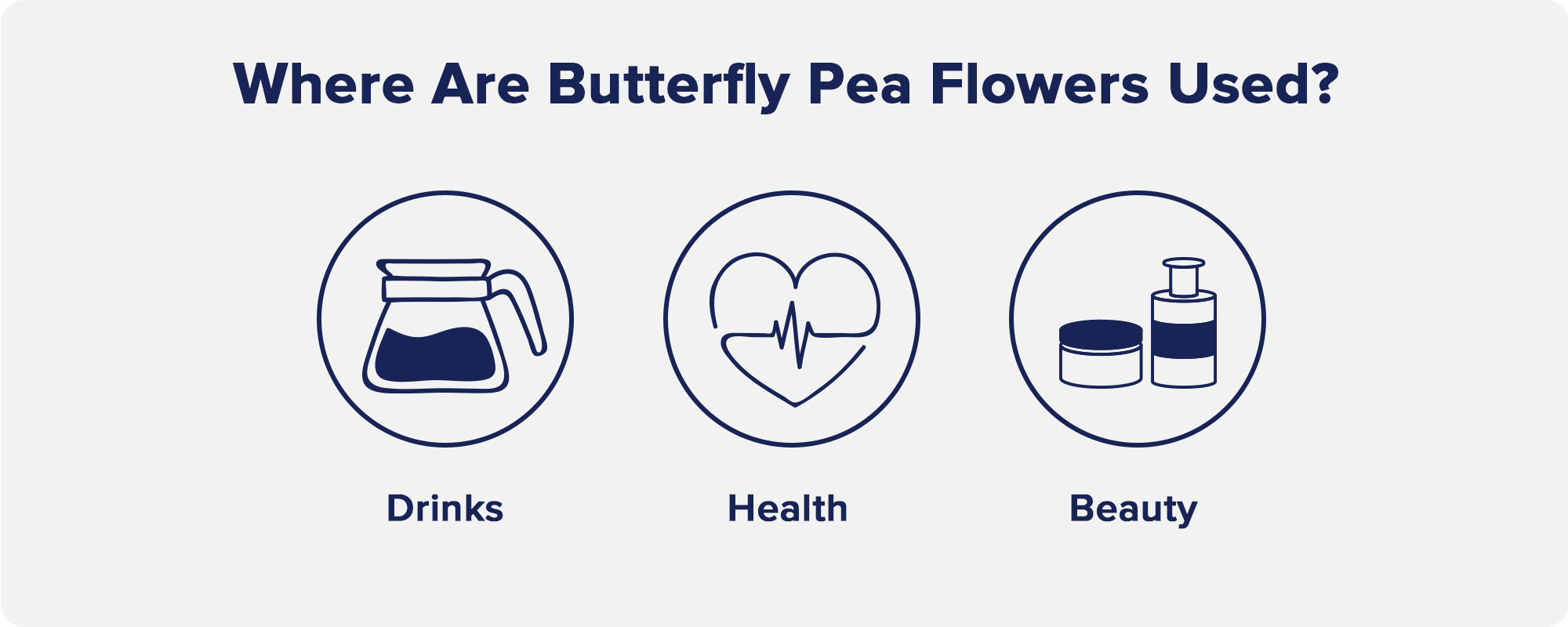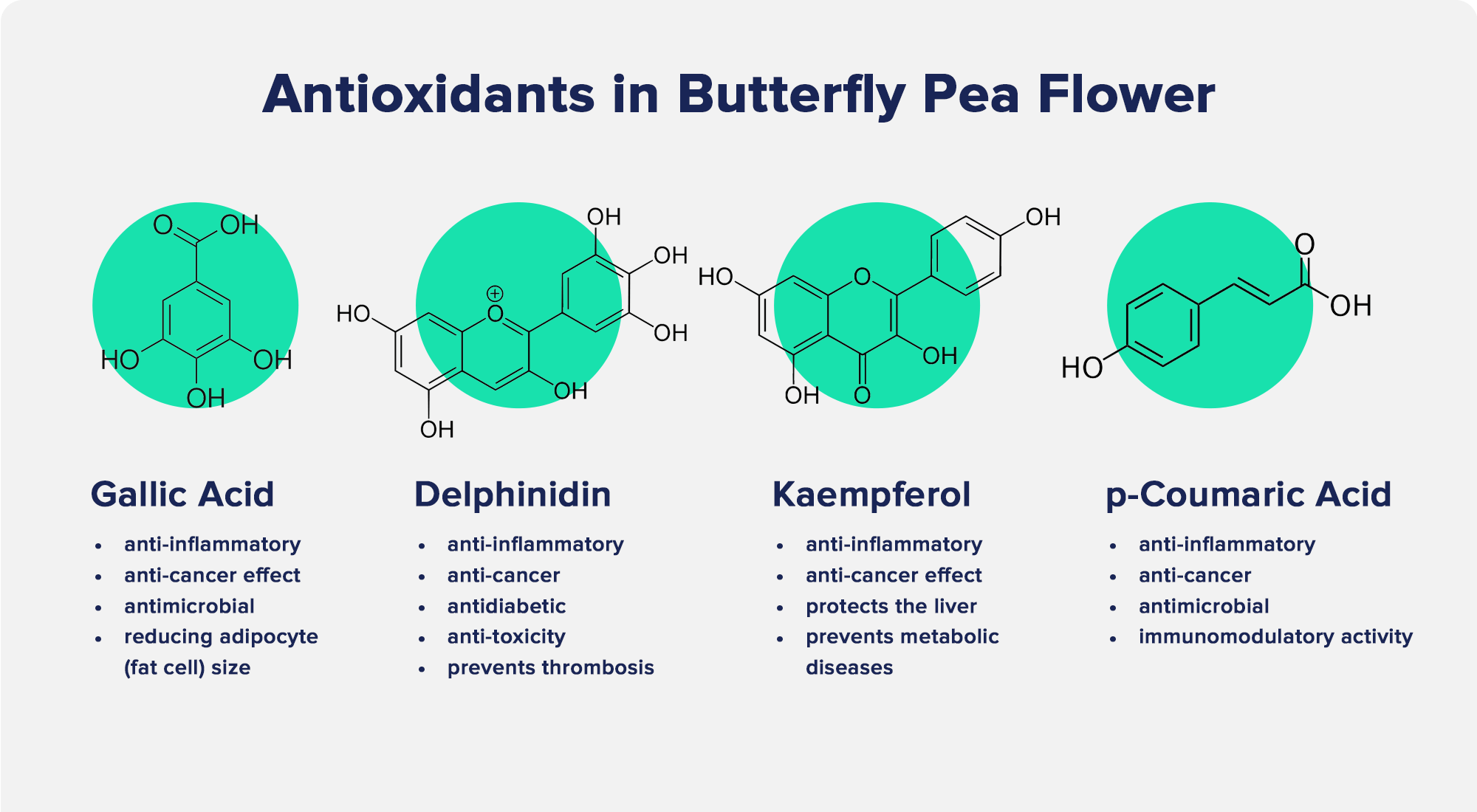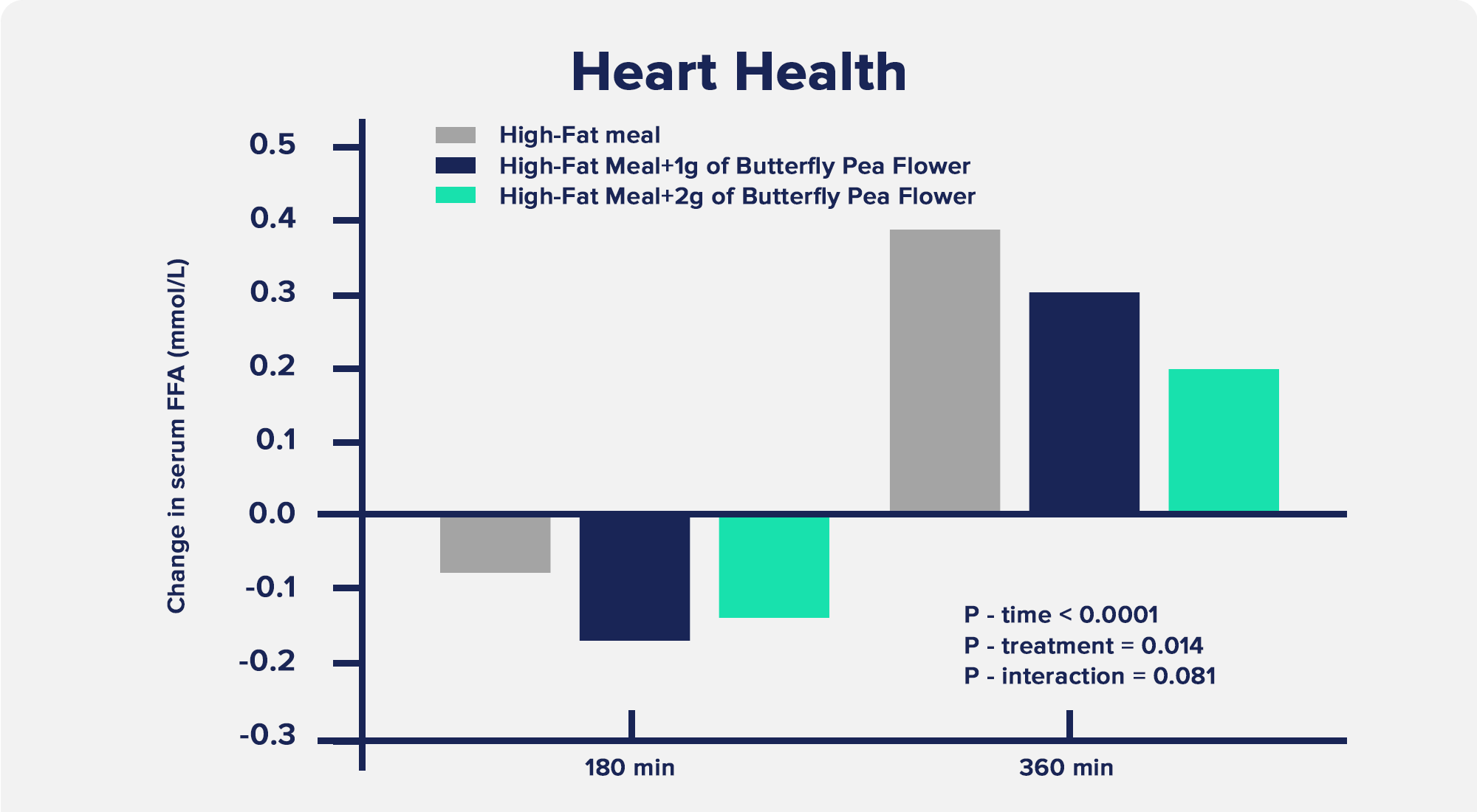Talk to a Registered Dietitian and use INSIDER20 for 20% off!
Talk to a real Dietitian for only $99: Schedule Now
This post contains links through which we may earn a small commission should you make a purchase from a brand. This in no way affects our ability to objectively critique the products and brands we review.
Evidence Based Research To fulfill our commitment to bringing our audience accurate and insightful content, our expert writers and medical reviewers rely on carefully curated research.
Read Our Editorial Policy
Known for its deep blue-purple color, butterfly pea flower is a commonly used ingredient in cocktails, teas, and beauty products.
But in recent years, researchers have looked to butterfly pea flower for more than just its vibrant color—it may also provide significant health benefits due to its anti-inflammatory and antioxidant qualities.
From skin improvements to weight loss to cardiovascular health, the potential health effects of butterfly pea flower are as dazzling as its hue—let’s take a closer look at its nutrients, benefits, and how to start using it.
Get a science-backed calorie & macro plan, built for your life.
Get a science-backed calorie & macro plan, built for your life.


Butterfly pea—also known as Asian pigeonwings, bluebellvine, blue pea, cordofan pea, Darwin pea, or its scientific name, Clitoria ternatea—is a plant native to Asia whose flowers are used for culinary and cosmetic purposes.

Due to its vivid blue color, many manufacturers use butterfly pea flowers as a natural dye for textiles, beverages, beauty products, and some foods.
It’s most often consumed in herbal teas or cocktails—as the acidity of the drink changes, the flower can change from blue to purple.
In addition to providing a pleasing color, the antioxidants found in butterfly pea flower contribute to its various health benefits.
Butterfly pea flowers are virtually calorie-free, containing no sugar, fat, or protein.
A brewed cup of butterfly pea flower tea contains about five calories and is caffeine-free.
Although devoid of vitamins and minerals, butterfly pea flowers are rich in antioxidants, including anthocyanins—a pigmented compound that also provides blueberries, red onions, grapes, and other foods with their blue hues and health benefits.
The top antioxidants found in butterfly pea flower are:
Gallic acid, a phenolic acid with anti-inflammatory and antimicrobial effects that has been studied for its potential role in reducing adipocyte (fat cell) size.

The butterfly pea plant also contains cyclotides—tiny proteins that form connective tissues in plants and exhibit anti-inflammatory and antimicrobial properties.
Because it’s rich in antioxidants, butterfly pea flowers are thought to fight inflammation and oxidative stress—the buildup of harmful molecules called free radicals or reactive oxygen species (ROS) that damage our cells, protein, and DNA.
As oxidative stress and inflammation are two driving forces of many chronic diseases, butterfly pea flower may help to prevent or slow disease progression.
In an animal study published in Antioxidants, mice who received butterfly pea flower had reduced markers of oxidative stress.
This included reductions in malondialdehyde (MDA)—a highly inflammatory molecule that is a byproduct of lipid peroxidation (when free radicals attack and oxidize fats).

Research has suggested that butterfly pea flower may be helpful for losing weight or maintaining a healthy weight—likely due to its antioxidant and anti-inflammatory qualities.
In a cell-based study in the lab, butterfly pea flower extract inhibited adipogenesis—the growth of new fat cells—and enhanced lipolysis in adipocytes, the breakdown of fat for energy.

While this is promising, we don’t have studies in humans that have looked at the effects of butterfly pea flower on body weight.
However, researchers have looked at how anthocyanins affect weight, finding that these antioxidants have anti-obesity effects.
For example, a systematic review and meta-analysis of randomized controlled trials published in Nutrients in 2021 found that anthocyanin supplementation for less than four weeks significantly reduced BMI (body mass index) in non-obese people.
Antioxidants are typically beneficial for skin health—both when used topically or consumed in foods.
This is likely one reason why people in some Asian countries—especially Vietnam, Malaysia, and Thailand—anecdotally consume butterfly pea tea for its anti-aging qualities.
Butterfly pea flower extract has been studied for its role in inhibiting the activity of collagenase—an enzyme that degrades collagen, a protein essential for skin structure, protection, and elasticity.
In a cell-based study published in Phytotherapy Research in 2018, a water extract of butterfly pea flower protected skin cells against UV-induced oxidative stress, which could be beneficial for fighting skin aging from sun damage.

Butterfly pea flower has exhibited many cardioprotective effects, including reducing oxidative stress and inflammation, improving cholesterol and lipid profiles, reducing blood pressure, and attenuating vascular dysfunction.
In a 2021 trial published in Biology, 16 overweight and obese men consumed a high-fat meal followed by 1g or 2g of butterfly pea flower extract or nothing.
The participants in the 2g group had reductions in serum triglyceride and free fatty acid levels six hours after the high-fat meal, in addition to increased antioxidant activity.

While this study did not measure longer-term effects of butterfly pea flower on lipid levels, a study in mice did.
Published in August 2022, this study found that six weeks of supplementing mice with a butterfly pea flower kombucha reduced LDL and total cholesterol, triglycerides, and markers of inflammation and oxidative stress.
However, it’s possible that some of the effects came from the fermented qualities of the kombucha tea, rather than solely the butterfly pea flower.
Lastly, butterfly pea flower may have some blood sugar-regulating effects.
In a 2018 study, 15 healthy men consumed five beverages at different times: sucrose water, 1g of butterfly pea flower extract in water, 2g of butterfly pea flower extract in water, sucrose plus 1g of butterfly pea flower extract in water, and sucrose plus of 2g of butterfly pea flower extract in water.
The participants’ plasma glucose and insulin levels were suppressed after drinking butterfly pea flower extract when it was mixed with sucrose, which would ordinarily spike blood glucose.
The consumption of butterfly pea flower extract on its own did not increase or decrease blood glucose levels, but this study suggests that consuming it with a sugar-rich meal could lessen the impact on blood glucose.

Butterfly pea flower is most commonly consumed in tea form, and can be purchased at many common retailers—a good choice is the PICKNATURE Organic Blue Butterfly Flower Loose Leaf Tea.
You can add 1 teaspoon of the dried flowers to 1 cup of hot water, steeping for 10-15 minutes before straining out the flowers.
Butterfly pea tea can be consumed hot or iced, and many people add lemon juice or honey to increase its flavor.
Adding lemon or any citrus will turn the tea from blue to purple due to the acidity acting on the tertanin compounds in the plant.
A traditional recipe in Vietnam and Thailand called nam dok anchan combines butterfly pea flower tea, sugar, and lime for a beautiful beverage reminiscent of a purple lemonade.

Butterfly pea flower is generally considered safe when consumed in moderation.
Some people report some side effects of nausea, stomach pain, or diarrhea after consuming butterfly pea flower, but there is no available research on its side effects.
Butterfly pea flower is likely more safe when consumed in tea form (as opposed to extract form), as the amount is more easily controlled and it’s difficult to consume too much.
If you’re wanting to consume butterfly pea flower in extract form, speak with your healthcare provider first if you have any underlying health conditions or are pregnant or breastfeeding, as the effects are not well-known.

Butterfly pea flower is generally described as tasteless or mildly floral.
Some say it is slightly sweet and earthy, reminiscent of chamomile or green tea.
Drinking butterfly pea flower tea may make you feel more calm—but it could be due to the calming effects of drinking warm beverages.
Although some people anecdotally state they feel less stress or happier after drinking it, there are no studies indicating that butterfly pea alters mood.
No, butterfly pea flower is not a psychedelic—although its vivid blue-purple coloring may make you think otherwise.
Chayaratanasin P, Caobi A, Suparpprom C, et al. Clitoria ternatea Flower Petal Extract Inhibits Adipogenesis and Lipid Accumulation in 3T3-L1 Preadipocytes by Downregulating Adipogenic Gene Expression. Molecules. 2019;24(10):1894. Published 2019 May 17. doi:10.3390/molecules24101894
Chen AY, Chen YC. A review of the dietary flavonoid, kaempferol on human health and cancer chemoprevention. Food Chem. 2013;138(4):2099-2107. doi:10.1016/j.foodchem.2012.11.139
Chusak C, Thilavech T, Henry CJ, Adisakwattana S. Acute effect of Clitoria ternatea flower beverage on glycemic response and antioxidant capacity in healthy subjects: a randomized crossover trial. BMC Complement Altern Med. 2018;18(1):6. Published 2018 Jan 8. doi:10.1186/s12906-017-2075-7
Maneesai P, Iampanichakul M, Chaihongsa N, et al. Butterfly Pea Flower (Clitoria ternatea Linn.) Extract Ameliorates Cardiovascular Dysfunction and Oxidative Stress in Nitric Oxide-Deficient Hypertensive Rats. Antioxidants (Basel). 2021;10(4):523. Published 2021 Mar 27. doi:10.3390/antiox10040523
Nair V, Bang WY, Schreckinger E, Andarwulan N, Cisneros-Zevallos L. Protective Role of Ternatin Anthocyanins and Quercetin Glycosides from Butterfly Pea (Clitoria ternatea Leguminosae) Blue Flower Petals against Lipopolysaccharide (LPS)-Induced Inflammation in Macrophage Cells. J Agric Food Chem. 2015;63(28):6355-6365. doi:10.1021/acs.jafc.5b00928
Park S, Choi M, Lee M. Effects of Anthocyanin Supplementation on Reduction of Obesity Criteria: A Systematic Review and Meta-Analysis of Randomized Controlled Trials. Nutrients. 2021;13(6):2121. Published 2021 Jun 21. doi:10.3390/nu13062121
Pei K, Ou J, Huang J, Ou S. p-Coumaric acid and its conjugates: dietary sources, pharmacokinetic properties and biological activities. J Sci Food Agric. 2016;96(9):2952-2962. doi:10.1002/jsfa.7578
Permatasari HK, Nurkolis F, Gunawan WB, et al. Modulation of gut microbiota and markers of metabolic syndrome in mice on cholesterol and fat enriched diet by butterfly pea flower kombucha. Curr Res Food Sci. 2022;5:1251-1265. Published 2022 Aug 18. doi:10.1016/j.crfs.2022.08.005
Tanaka M, Sugama A, Sumi K, et al. Gallic acid regulates adipocyte hypertrophy and suppresses inflammatory gene expression induced by the paracrine interaction between adipocytes and macrophages in vitro and in vivo. Nutr Res. 2020;73:58-66. doi:10.1016/j.nutres.2019.09.007
Thilavech T, Adisakwattana S, Channuwong P, et al. Clitoria ternatea Flower Extract Attenuates Postprandial Lipemia and Increases Plasma Antioxidant Status Responses to a High-Fat Meal Challenge in Overweight and Obese Participants. Biology (Basel). 2021;10(10):975. Published 2021 Sep 28. doi:10.3390/biology10100975
Zagórska-Dziok M, Ziemlewska A, Bujak T, Nizioł-Łukaszewska Z, Hordyjewicz-Baran Z. Cosmetic and Dermatological Properties of Selected Ayurvedic Plant Extracts. Molecules. 2021;26(3):614. Published 2021 Jan 25. doi:10.3390/molecules26030614
Zakaria NNA, Okello EJ, Howes MJ, Birch-Machin MA, Bowman A. In vitro protective effects of an aqueous extract of Clitoria ternatea L. flower against hydrogen peroxide-induced cytotoxicity and UV-induced mtDNA damage in human keratinocytes. Phytother Res. 2018;32(6):1064-1072. doi:10.1002/ptr.6045
1 Comment
The contents revealed in this report is quite amazing. Though I have been using it for a long time, my being a natural food & beverage consumer. I didn’t know the facts about (BBPF) Blue Butterfly Pea Flower tea (Blue Tea) which pick from my home grown BBPF. I am 62 years and maintain a very sound health & I trust BBPF tea must have contributed immensely to my personal health.
As the facts encourage me, hoping to expand my cultivation of BBP to a small domestic industry.
Thank you for the insights of BBPF presented.